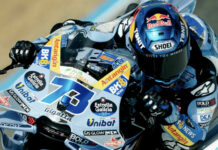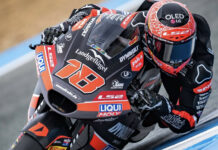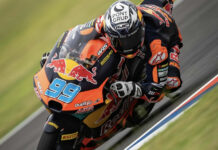From a press release issued by Ducati Corse:
DUCATI MARLBORO TEAM – PRESS INFORMATION
April 17 2003
DUCATI MARLBORO TEAM EMBARKS ON AFRICAN ADVENTURE
Three weeks after its historic MotoGP debut in Japan, the Ducati Marlboro Team comes to South Africa for what is expected to be an altogether more demanding event for riders Loris Capirossi and Troy Bayliss.
The Italian and the Australian, who finished a remarkable third and fifth at Suzuka, have never tested the Desmosedici at this tight, bumpy and slippery racetrack. The riders and their engineers thus face a major challenge to refine the bike’s set-up in time for Sunday’s race, round two of this year’s 16-event MotoGP World Championship.
After Welkom the MotoGP circus heads home to its European heartland for the nine race Continental sector of the series, commencing with the Spanish GP at Jerez on May 11. The 2003 campaign concludes with four more flyway races in South America and the Pacific rim region, with the season-ending Valencia GP on November 2.
DOMENICALI: ‘WELKOM WILL BE HARDER’
Despite the Ducati Marlboro Team’s impressive speed in preseason testing, even the most optimistic crew members didn’t dare hope for such a rousing debut at Suzuka. Loris Capirossi led the race and finished a brilliant third, while Troy Bayliss took a superb fifth-place result on his MotoGP debut. Now the team focuses its attention on the long haul – 15 more GPs, many at tracks where the Desmosedici has never run before.
Sunday’s Africa’s GP is the first of these, which is why Ducati Corse managing director Claudio Domenicali expects a challenging weekend for his riders and crew. “Welkom will be harder, because we’ve had no opportunity to test there,” he says. “And also because it’s a tighter circuit, and so far our bike has worked better at faster circuits where it can show its speed. It will be a struggle to find the set-up in such a short time.”
Nevertheless, Ducati Corse’s philosophy has always been a minimum of machine adjustments from one circuit to another. This ‘leave it alone’ rationale has worked wonders in World Superbike and is already bearing fruit in MotoGP, with the Desmosedici on the pace at Suzuka and at every track visited during preseason testing. User-friendliness is vital in bike racing, since rider confidence is everything, and confidence can be increased by maintaining the same set-up wherever possible, allowing the rider to anticipate the limit and to predict how the bike might behave when he reaches, or even slightly exceeds, that limit.
“Our main concern is always to look for a set-up that works everywhere,” reveals Ducati Marlboro Team technical director Corrado Cecchinelli. “Whenever we go to a track we touch the set-up as little as possible, so riders can get used to the bike and get the best out of it. There’s no point in always looking for perfection and always changing things, because the rider will never get used to how the machine behaves.”
When visiting new tracks, Cecchinelli and his crew have to indulge in a little guesstimating. “When we go to a track we don’t know at all, we have to guess the gearing,” he adds. “We imagine what the top speed should be, then we look at the slowest turn to guess what the slowest speed should be. We also talk with Loris because he’s got the experience, so he knows the speed of every corner. But gearing isn’t that acute an issue, since our engine has a wide rpm range.” Mechanics need just 15 minutes to change the V4’s entire gearbox cluster, but between 30 minutes and one hour to change individual ratios.
But Cecchinelli doesn’t expect the venue’s 1350m altitude to be a problem. “With a good engine management system you shouldn’t have to change anything,” he concludes. “We already know the situation from racing Superbikes at Kyalami. After all, when you ride a bike up a mountain, you don’t change the carburation, the bike’s just slower, that’s all.”
Both Capirossi and Bayliss tested their development Desmosedicis at Mugello on April 14 and 15, riding alongside tester Vittoriano Guareschi, who focused on the development bike.
CAPIROSSI LIKES A WELKOM CHALLENGE
Loris Capirossi was a star performer at Suzuka three weeks ago – fastest in the only dry practice session, race leader and third-place finisher in the first race for the Ducati Marlboro Team Desmosedici. Now the little Italian comes to Welkom, where he has always impressed.
Capirossi has finished on the podium on his last three visits to the South African venue. He took third in 2000, a close-run second behind Valentino Rossi in 2001, when he was riding a year-old Honda NSR500 against Rossi’s brand-new model, and third last year, when he was far and away the quickest two-stroke rider. The circuit – bumpy, dusty and more slippery than most – is a fighter’s track, and that suits Capirossi just fine.
“I always go good there, from the very first time, though I’m not really sure why,” he says. “It’s not a special kind of racetrack, but there are a lot of difficult corners and I guess I like difficult corners. The last part of the track is very tricky and very important, especially the two fastest corners, the first that leads onto the back straight, the second which takes you off it. I like fast corners and I like fast tracks. I know that I can give 110 per cent at Welkom but I also know that maybe it won’t be the best track for us. It’s hot and the surface is pretty bad, so you get a lot of wheelspin there.
“We got a great result at Suzuka, better than we expected for our first race with this bike. Everyone has worked so hard to get us where we are, and we have already shown that the bike’s potential is very high, but this is only the very beginning.”
BAYLISS MAKES WELKOM DEBUT
Troy Bayliss’ stunning ride to fifth place at Suzuka – his first-ever MotoGP race on his first visit to the complex Japanese track – suggests that the Australian won’t be fazed by the prospect of competing at another 12 circuits that are new to him during his debut MotoGP campaign.
The Ducati Marlboro Team rider will see the Welkom circuit for the very first time when he arrives at the venue midweek. “I can’t even remember if I’ve watched any of the Welkom GPs on TV,” smiles the former World Superbike champ. “I only really started watching the GPs halfway through last season, once I knew I’d be riding in them. It’ll be another busy weekend for all of us, but in some ways it should be better than Suzuka, because all the guys have only raced at Welkom a few times, whereas there were plenty of specialists at Suzuka, guys who’d been racing there for ten years and who’d done a bunch of Eight Hour races.”
Bayliss’ first full race on the Desmosedici certainly gave him some ideas to improve the bike, which is still very much in its infancy. “We’re still missing a couple of things with the bike, I didn’t feel fully comfortable at Suzuka,” he adds. “When we do find what we’re looking for, the bike will be really nice. One thing I noticed over race distance at Suzuka was that I was taking too much wind on my upper body through the fast corners and down the straights. We should learn something like that at every race, which will help us make the bike even better. That’s why I’m looking forward to all the races, and I’ll be doing my best wherever we go.”
This may be Bayliss’ first Welkom ride but he’s no stranger to South African success – winning both World Superbike races at Kyalami last year.
THE TRACK
The Phakisa Freeway circuit returned South Africa to the GP calendar in October 1999 after a seven-year absence, the Free State venue replacing Johannesburg circuit Kyalami which had hosted the nation’s four previous GPs in 1983, ’84, ’85 and ’92. Constructed outside the gold-mining town of Welkom, the circuit is a real challenge, especially for tyres, which run at a higher temperature than at any other GP track.
But the defining characteristics of this circuit are its bumpy surface and lack of grip, though the track has been resurfaced for 2003. Welkom isn’t used as much as most international racing venues, so dust tends to settle deep into the tarmac and is then drawn out as the GP bikes ride across the surface, dramatically reducing grip. The traction tends to improve day by day over the Grand Prix weekend but these day-on-day changes bring their own problems because the differing grip levels require different tyres and different chassis set-ups.
Situated on a plateau 1350 metres above sea level, the venue’s high altitude has a huge effect on performance, robbing engines of up to 20 per cent of their horsepower.
Phakisa Freeway
4.242km/2.636 miles
Pole position 2002: Valentino Rossi (Honda) 1m 34.660s
Lap record: Tohru Ukawa (Honda) 1m 34.834s, 161.030kmh/100.06mph
DUCATI MARLBORO TEAM DATA LOGS
TROY BAYLISS
Age: 34
Lives: Monaco
Bike: Ducati Marlboro Team Desmosedici
First GP: Australia, 1997 (250)
GP starts: 2 (1xMotoGP, 1×250)
World Superbike victories: 22
World Championships: 1 (Superbike: 2001)
Welkom 2002 results: DNS
LORIS CAPIROSSI
Age: 30
Lives: Monaco
Bike: Ducati Marlboro Team Desmosedici
GP victories: 22 (2×500, 12×250, 8×125)
First GP victory: Britain, 1990 (125)
First GP: Japan, 1990 (125)
GP starts: 185 (15xMotoGP, 59×500, 84×250, 27×125)
Pole positions: 33 (5×500, 23×250, 5×125)
First pole: Australia, 1991 (125)
World Championships: 3 (125: 1990, 1991, 250: 1998)
Welkom 2002 results. Grid: 2nd Race: 3rd






